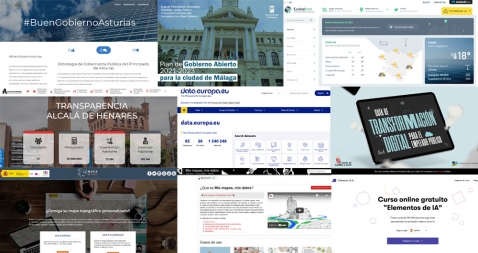What's new in the open data ecosystem (spring 2021)?
Fecha de la noticia: 15-06-2021

Spring is coming to an end to give way to summer, holidays and warm weather. As with every change of season, for the Aporta Initiative it is time to review what has happened in the open data ecosystem over the last three months.
Boosting data strategies
During this season we have seen several initiatives, both local and statewide, launch processes to update their data strategies:
- In April, Málaga City Council presented a Municipal Open Government Plan that includes initiatives to promote open data. Specifically, the development of information campaigns, the homogenisation of dataset formats and the progressive incorporation of new datasets, also including data external to municipal management.
- The Community of Murcia launched a survey aimed at companies in the region to find out which datasets are of interest to them, with the aim of assessing their incorporation into the region's open data catalogue.
- The Government of Asturias carried out a participatory process to develop a Public Governance Strategy. Among other aspects, it aims to implement mechanisms to facilitate participation and access to open data.
- The Ministry of Economic Affairs and Digital Transformation has launched a consultation to identify proposals for the integration of Artificial Intelligence in the value chains of different sectors of the economy. All this within the framework of the National Artificial Intelligence Strategy.
The commitment to open data by Spanish public bodies is also evident in the growing support for the International Open Data Charter. Spanish representation in the Open Data Charter has grown this spring: two autonomous communities, Asturias and Valencia, and one local authority, the City Council of Pinto, agreed to join.
New portals and open datasets
In addition to the bloom, spring has also brought us new open data sharing platforms:
- Alcalá de Henares Town Council has developed a new Transparency and Open Data Portal to facilitate access to information and promote transparency in its management.
- A new version of Euskalmet, the meteorological service of the Basque Country, has also been launched. The portal includes an API Rest for reusers.
- The Spanish Patent and Trademark Office has presented a new version of its Open Data portal in a new format. Through it, users can access reusable data of all types of Industrial Property, available in PDF, XML or SGML formats, among others.
Other existing portals have opted to incorporate new tools:
- The Territorial Information Service of the Balearic Islands (Sitibsa) has launched a tool to automatically incorporate open data from its portal to the map service of the Spatial Data Infrastructure of the Balearic Islands (Ideib).
- The National Centre for Geographic Information (CNIG) has published the web application 'Mapa a la Carta', which allows to customise topographic maps.
- GeoPamplona, the geographic information system developed by the city council, has incorporated new features to improve the user experience and make the service more accessible to citizens. One example is its new catalogue of maps with information already selected, so that the user does not have to search for it.
- Zaragoza City Council has created 'Mis mapas, mis datos', a tool for creating simple and complex maps, combining various data sources.
Moreover, as usual, the vast majority of open data initiatives have been updating their data on a regular basis. Some of the new features that have been presented in recent months are the cultural heritage maps of each municipality on the Barcelona Provincial Council portal or the data on the state of the Mar Menor on the Murcia portal.
Events and training materials are growing
During these months we have attended many events and webinars related to open data. Some of them have been recorded and are available for viewing at any time:
- A few days before the arrival of spring, in March, there was the conference "Data in Local Administrations 20/30. Experiences and Challenges", organised by Alcobendas City Council, the Institute for Knowledge Transfer in Public Innovation (ITCIP) and the Innovation Club, with the support of the FEMP (Network of Local Entities for Transparency and Participation), the Spanish Network of Smart Cities - RECI and Oracle. The different sessions can be viewed here.
- On 23 April, a round table was held, within the framework of the Master in Technology and Digital Innovation in Engineering of the UNED, on "Big Data and datos abiertos applied to mobility". If you missed it, you can watch it on Youtube.
In addition, some courses, guides and books have been launched for those who want to broaden their knowledge of new technologies and data:
- The central government has launched the Elements of AI project in Spain. This is a free online course aimed at all citizens that offers training in the basic fundamentals of Artificial Intelligence.
- Castilla y León has presented the 'Digital transformation guide for public employees', which has a section dedicated to open data. It explains what open data is, talks about the National Open Data catalogue (datos.gob.es) and highlights the importance of reusing information in the public sector.
- The Geomatics and Surveying Engineering Forum of the IDEE Working Group publishes a new version of the book 'Spatial Data Infrastructures', which emphasises the publication and description of spatial datasets by means of services. Among other issues, it includes how they should be presented through viewers and catalogues for their management and exploitation.
Re-use of data by public administrations and citizens
The impact of open data has also become evident in recent months thanks to multiple examples. On the one hand, we have a number of public administrations that have taken advantage of the value of data to implement projects that improve their efficiency and the service they provide to citizens:
- The Madrid Tax Agency has launched a project to use Big Data and Artificial Intelligence to fight municipal tax fraud. A Tax Laboratory will lead this strategy by incorporating information from the City Council's Open Data Portal.
- The Provincial Council of Valencia starts the project 'Connecta València: tourist, intelligent and sustainable territory', which analyses tourist data to adapt and improve the experience in all its municipalities.
- Barcelona City Council has promoted the pilot project 'Dades x Comerç', developed by BCNOpenData to help small businesses make decisions and better understand customer behaviour based on open data.
On the other hand, companies and entrepreneurs have used data to create products, for example:
- The elections to the Community of Madrid left us with multiple examples of journalistic pieces developed based on open data, such as these from El Pais o eldiario.es.
- Two people from Bilbao have created CityAr, an app where users can organise routes, participate in events or play games through augmented reality. CityAr uses Bilbao's open data to show the city's cultural and leisure offer.
In this period, the call for two awards aimed at re-users has also been announced:
- The Asedie Awards 2021, for companies, institutions and open data projects that can contribute social and/or economic value. The deadline for applications is 15 September 2021.
- The new edition of the open data competition organised every year by Castilla y León, aimed at journalists, teachers, students or data reusers. Those interested in participating must send their proposal before 13 July.
A couple of global developments
At the international level, one of the main developments has been the launch of the new European data portal, data.europa.eu, which is positioned as a single access point for data from all over Europe. Its development and management for the next 6 years has been awarded to a consortium comprising, among others, the Ontological Engineering Group of the Polytechnic University of Madrid.
For its part, Asia has launched its first official portal that will bring together open data published by institutions, agencies and organisations from the different countries that make up the continent.
With these examples, it is clear that the open data ecosystem does not stop and continues to evolve month by month. If you want to share any other news that you consider of interest, we invite you to tell us your opinion in the comments section.














